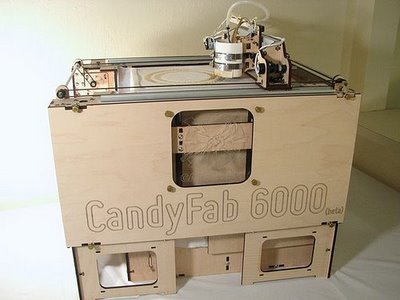But the really interesting part is that the calorie-laden printed objects are in fact edible! One can only imagine the amazing items emerging from gourmet dessert kitchens once these things are widely available. 3D software training for chefs? Would Gordon Ramsay scream at the printer?
But then:
Evil Mad Science plans to announce the availability of CandyFab kits sometime in the summer or fall of 2009.
Yes, there will be kits.
Won’t quite be as inexpensive as the Cupcake CNC. It’s a more complex machine, supporting a deep, heavy bed of material and a build volume ten times as large. Still, we’ll do what we can. 🙂
- New mechanical parts, and no requirement to re-use old printer components
- Upgraded sofware: the cross-platform CandyFabulous
- Build volume of 10 Liters
- Layer thickness of 0.067 inches
- One Arduino board per axis
- Food-safe sugar containment
- Laser-cut casing
- Highly expandable
As the Evil Mad Scientist says, “it’s looking sweet.”
Via Evil Mad Scientist, CandyFab wiki and Thingiverse (hat tip to Thomas Amberg, once again!)



![Reblog this post [with Zemanta]](http://img.zemanta.com/reblog_e.png?x-id=fd8dad39-d68a-49a7-9211-08201ec165f9)
Edible items seem to be allowed to be unique. Home made cakes and such are actually preferred to more mass produced versions. Could printed food be one of the early uses for home printing technology?
Printed mii avatars for use on Wedding/Birthday cakes. What other business opportunities for printed food are there?